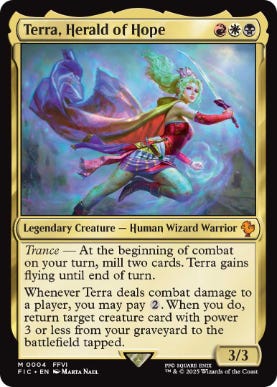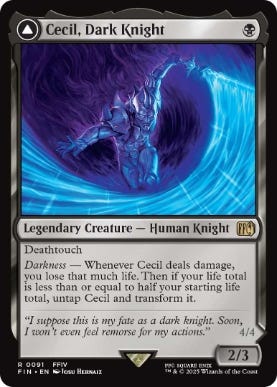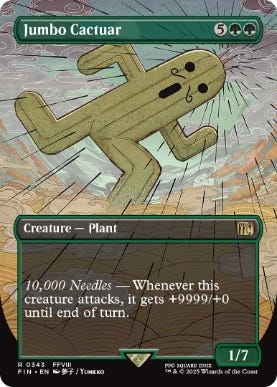Welcome back to the Wark Digest, your weekly newsletter of new developments and historical insights from the Final Fantasy universe. I’m Chris, aka Hoogathy, and this week Magic: The Gathering has pressed the Square button to challenge us to a game of cards, and a Sony legend has shed a little light on a contentious moment in Square history.
This week’s newsletter is 2657 words, a 13-minute read.
“Wanna Play Cards?”
Wizards of the Coast has truly begun pulling back the curtain on Final Fantasy’s crossover with their trading card game, Magic: The Gathering. This week we got our first proper look at some of the cards and unique elements that will translate the storied franchise into the world’s premier TCG.
What’s going on:
First, a quick description of MTG for the uninitiated: the game is a duel between 2+ players, who each have a deck of 60+ cards; players can place a “basic land” card once per turn and use them to play the other cards in their deck, summoning creatures to fight for them or directing attacking their opponent with spells like fireballs; the main goal is to reduce your opponent’s health to 0
The colour symbols in the top right corner of a MTG card inform a lot of aspects of the game itself
To put it in the terms of another TCG, Pokémon: basic lands are like energy cards, MTG’s creatures are like Pokémon, and other spells are like Trainer cards; the colour symbols on a MTG card (white, blue, etc) are like the types on a PTCG card (Fire, Dragon, Steel, etc)
Much like Pokémon TCG, half the hype for MTG is in collecting the cards, though the ratio of players to collectors would be more even for Magic
In recent years, “variant” cards have become very desirable—different versions of standard cards with expanded artwork, different card frames, or various other cosmetic upgrades
We’ve known for a while that MTG was including Final Fantasy in its “Universes Beyond” initiative, a product line that incorporates famous IPs into its genre-defining game design, and after a small art tease back in November, we finally got to see what this will actually look like
The crossover takes the form of a full, proper, “tentpole” release for MTG, meaning it’s an full-fledging set (and not just a couple of promotional standalone products)
Cards will be available in a variety of products: booster packs containing randomized cards at certain rarities (in regular Play Boosters, or premium Collector Boosters), Bundles (and fancier Gift Bundles) containing multiple boosters and other goodies, a Starter Kit with two regular decks for learning the game, and ready-to-play decks for the game’s popular Commander format
There are four different Commander Decks, each focused on a particular game and with its protagonist at the forefront: FFVI with Terra, FFVII with Cloud, FFX with Tidus, and FFXIV with Y’shtola
Commander is a unique format, in that you make a deck of exactly 100 cards with no duplicates (aside from the basic land cards that power the game) designate a Legendary Creature from your deck to be your “Commander;” your choice of Commander determines which of the five colours you can use in your deck
The cards revealed this week cover a swath of familiar ground from Final Fantasy: we saw party members like Cecil and Yuffie, side characters like Stiltzkin, iconic creatures like Cactuars and Tonberries, and even summons (Shiva) and sidequests (like Noctis’ fishing addiction)
Cecil, Garland, and Emet-Selch use a MTG mechanic called double-faced cards, which they first introduced to convey the concept of a creature transforming into a werewolf; you play the card with its main face up, and once a certain condition is met, you flip the card over and play it with those features instead (for example, Cecil starts as a Dark Knight and transforms into a Paladin)
Summons put an interesting twist on a classic MTG card type to convey the feeling of calling them onto the battlefield for a limited time
Likewise, WOTC found novel ways to recreate a Tonberry’s slow gait, or the devastating power of a Cactuar’s 1000 Needles
A subset of cards called “Final Fantasy Through The Ages” will utilize beloved artwork from the games as full-art variants (like Amano’s iconic art of the Warrior of Light dodging a dragon’s fiery breath, or Yuffie’s original artwork)
Yoshitaka Amano and Tetsuya Nomura have also been confirmed to be contributing artwork to the set, but so far only those reprints mentioned above have been shown, nothing original
In addition, there will be three “Secret Lair” card mini-sets to coincide with the main set—Secret Lair being a sort of small-run variants, usually centered on specific themes or artists
The earliest Universes Beyond collabs, like Fortnite and The Walking Dead, started as Secret Lairs, while Wizards has also done charity work through these



What we thought:
Again, as a longtime fan of MTG, this is an awesome intersection of my interests, and I’m quite impressed with what they’ve shown so far
MTG has a penchant for “flavourful” game design—flavour being the “metaphor” or story behind the game itself, particularly in tabletop games, or in other terms, “the way the game pieces make you feel like you’re actually living the story of the games”
Think Monopoly: you land on a square with another player’s icon on it and give them some fake money, imitating the act of paying to rent a hotel
Just about everything they’ve shown so far has nailed the “flavour” of Final Fantasy, as I hoped it would—you play Cloud, and he arrives with the Buster Sword; you play a Tonberry, and it takes extra time to be able to attack your opponent, but is very lethal; Emet-Selch is enraged when a certain number of allies are sent to the graveyard and transforms into a new boss phase; etc
There’s been a lot of talk about the Jumbo Cactuar card in particular, as it can do up to 9999 damage… in a game where players start with only 20 HP
Naturally, FF fans get why it does that much damage, but considering this set is Standard legal (or, “permitted for use in official tournaments”), MTG veterans without knowledge or love of FF are reeling from the potential ramifications of such an incredibly dangerous card
It’s such an incredibly bonkers card, I won’t be surprised if it gets banned from at least one of the game’s formats almost immediately after release
If I had to wager a guess, I’d suspect that one of the three Secret Lairs could be based around Amano’s art, and maybe another for Nomura
Now, MTG can seem like a very intimidating game, with its various formats, potentially expensive products, and a focus on tournaments and in-store play… but let me tell you, it’s at its best when you can get together with a couple friends and play a casual game around your kitchen table, and if you happen to have friends who are into Final Fantasy, this could be the recipeh for some incredibly fun game nights
Also, don’t get intimidated by some of the prices—Play Boosters are a better purchase for most people, instead of the Collector Boosters, for example
What’s next? Magic: The Gathering—Final Fantasy goes on sale June 13, and there will likely be “prerelease” tournament events at local game stores the week prior. Wizards of the Coast has said they’ll do a full reveal in May.
In the meantime, has all the hype so far stirred your interest? Would you be interested in seeing some more “learn to play” tutorials geared specifically for the FFxMTG set? Let us know in the comments below!
“Until FFVII, The Saturn Was Doing Better”
Shuhei Yoshida, a mainstay of the industry and one of the biggest names at PlayStation, left Sony last month after an incredible 38-year run. Now as he transitions to a new position working with indie devs, he spoke to Venture Beat’s Dean Takahashi about his illustrious career, and in the process showed another perspective on how Final Fantasy helped change the face of video games.
What they’re saying:
Yoshida started at Sony in 1986, then joined Ken Kutaragi’s PlayStation team in 1993, about a year after their fledgling partnership with Nintendo collapsed
He became the lead account manager for Japan, and his job then “was to talk to the publishers and developers in Japan and recruit them to make games for PlayStation,” though as he recalls many SNES developers “didn’t get it”—thinking 3D was only for certain genres, and disliking how the PlayStation didn’t use familiar techniques they relied on (like sprites)
It was actually Namco who was the first to truly bite, seeing the potential to port their 3D arcade games to home consoles
Both Square and Enix were big potential allies, as new Final Fantasy and Dragon Quest releases were becoming cultural phenomena nationwide
When Yoshida reached out to Square, he learned Square had asked Nintendo to utilize CDs, to no avail; Hironobu Sakaguchi “loved the potential of CDs” and creating movie-level effects for a FF was his dream
After some schmoozing, Sony’s execs convinced Square’s to do the unthinkable, and Enix made the same call—both companies seeking to release their games for the biggest user bases
Around this time, Sega Saturn was in a stronger position in Japan, thanks to popular arcade titles like Virtua Fighter and its sequel, but selling the PlayStation for $100 less than the Saturn helped turn the market’s tide, and so did blockbusters like FFVII
“Until we announced that Final Fantasy VII was coming to the PlayStation, the Saturn was actually doing better. That was the most difficult time.”
Christmas of 1995 was a particularly bleak moment, with Virtua Fighter 2 success on the Saturn dealing Sony a strong blow; Sony’s marketing team rallied in the new year by announcing FFVII would be on PlayStation
“At the third-party relations team I felt like we’d lost our goal. We were getting Final Fantasy and Dragon Quest [but] didn’t have anything else in Japan in terms of popular IP to target”
FFVII was a big win, but it was still early in development, a year from release
However, that spring Sony Computer Entertainment of America made a global deal with Universal Interactive and Mark Cerny to exclusively publish Crash the Bandicoot (and later Spyro the Dragon)
Yoshida served as localization director on the first Crash, then Gran Turismo, and was instrumental in developing some other hits like ICO, Ape Escape, and Legend of Dragoon
Building confidence from publishers like Square was paramount, and at the time “Major publishers told us, ‘Sure, we’ll bring you our games if you can sell a million units of hardware quickly’”—make good games to sell hardware to attract more good games to sell more hardware, etc.
Despite decent launches in each market, balancing Japanese titles with “US-made sports games and European games like Wipeout,” “the second year of the original PlayStation was very hard. I was very concerned,” Yoshida recalls
“PS3 was another hard time. At the time I was part of management, so I could see the financials. We were losing a billion dollars. I thought PlayStation was finished. But luckily, at that time Sony’s flatscreen TVs were hugely popular. The TV group was making enough money to cover the losses from the PS3 and we were able to survive. But that was the most difficult time”
“when PS3 launched, that was the first time many programmers had faced [multi-core programming]. Our graphics hardware was less powerful than the Xbox 360 as well, the Nvidia chip. Mark Cerny and the Naughty Dog engineers would use the Cell processor, which was powerful but hard to use, to help render the graphics. Part of the CPU would do the GPU’s job. That became our internal game engine.”
What we thought:
It was a huge gamble then, but with every new wrinkle we learn about the Square deal, it makes even more sense
It’s well-known that Square was wooed to PlayStation by the CD-ROM, but Yoshida’s remarks shine a light on just how important Square (and FFVII) proved for the PlayStation
Building a foundation or niche in the market, then building upon it with the reciprocal relationship between hardware and software, was fundamental
As one of the first to take the risk, Square gave a big endorsement, leading others to take the same chance… and gradually, a rising tide lifts all boats
Then in a roundabout, indirect way… is Square kinda responsible for getting Crash Bandicoot on PlayStation?
From a western perspective, it’s bizarre to think that the Sega Saturn was ever a real threat to Sony or Nintendo, but it had a decent start in Japan
If Sega hadn’t shot themselves in the foot by releasing the 32X add-on for Genesis/Mega Drive in the same year, this front of the “console war” might’ve been a more protracted struggle
Also, Square and Enix being the pioneers who threw their lot in with Sony not only foreshadows their merger, but speaks to their power in the industry before the merger as well—PlayStation had secured two of the biggest IPs in Japan, each infamous for inspiring swaths of students to skip school on their release dates
Ironic as well, that multicore programming is now a wide-spread practice
In this tale, Square and Final Fantasy are but one piece of a complex puzzle, but nonetheless, their show of faith in CD-ROMs proved to be instrumental
What’s next? Yoshida won the BAFTA Fellowship Award in 2023, an honour that has previously gone to video game creators like John Carmack, Shigeru Miyamoto, and Peter Molyneux (to say nothing of big Hollywood names like Steven Spielberg or Christopher Lee). The BAFTA Fellowship is a lifetime achievement award for “outstanding achievement in the art forms of the moving image,” and its 2025 award was just given to Warwick Davis, of Star Wars and Willow fame, last week.
Around the Union
We’ve all been there before: you think you’re kicking butt in a long dungeon, late in a game, and all of a sudden your party is turned into statues and you’ve lost 40 minutes of progress. Or, you come across a big green plant with teeth and worst breath you can imagine through a TV screen, and now your party is blind but irrevocably attacking themselves. Status effects can have a profound impact on your gaming sessions, when it comes to RPGs, and this week we’re looking at “The 7 Most Annoying Status Effects in Final Fantasy!” Did your least favourite crack our list, or do you have a great anecdote to share? Sound off in the comments below!
Meanwhile over in our premium newsletter, the Kupo Chronicle, we’re marking its first anniversary by returning to Final Fantasy VIII and examining the development history behind Laguna’s portion of the game. How would FFVIII have changed if Laguna had as much screen time as Squall?
Kupo Chronicle #27 - Fragments of Memories
Welcome to the Kupo Chronicle, the premium edition of the Wark Digest newsletter, where we explore the Final Fantasy universe in long-form and drill down into unique moments of the series’ history. I’m Chris, aka Hoogathy, and in this installment we hit the library of Balamb Garden to seek the
Now you’re up to speed! From the whole team at Final Fantasy Union, thank you for subscribing. Please let us know what you think of our coverage, and what you’d like to see covered in our weekly installments. As ever, if you’ve enjoyed our work, please share it with your friends!
Join the discussion on our Discord!
Or, find Final Fantasy Union on social media: Facebook | Instagram | Bluesky |
Until next time, kupo!








“Would you be interested in seeing some more “learn to play” tutorials geared specifically for the FFxMTG set?” YES please
Also, Re: Jumbo Cactuar, I LOVE that you can see Irvine dancing around the needles in the lower middle of the regular art, with Rinoa about to launch an attack in the bottom right